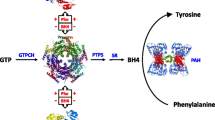Summary
We examined the value of the fasting plasma phenylalanine/tyrosine ratio obtained in an ordinary clinical setting for assessing the probability of being a heterozygote for hyperphenylalaninaemia. This biochemical test was found to be of little value in those with a high (66%) prior risk of heterozygosity, because it could not reduce the risk below 12%. However, in a population with a prior risk of only 2%, it discriminates the 3% with a 19% risk from the 97% with a risk of 1.5% or less. This simple method could usefully be applied to such a population, in order to select those at higher risk for further investigation using molecular genetics.
Similar content being viewed by others
References
Anderson JA, Graven H, Ertel R, Fisch R (1962) Identification of heterozygotes with phenylketonuria on basis of blood tyrosine responses.J Pediatr 61: 603–609.
Berry H, Sutherland B, Guest GM (1957) Phenylalanine tolerance tests on relatives of phenylketonuric children.Am J Hum Genet 9: 310–316.
Blau K, Summer GK, Newsome HC, Edwards CH, Mamer OA (1973) Phenylalanine loading and aromatic acid secretion in normal subjects and heterozygotes for phenylketonuria.Clin Chim Acta 45: 183–192.
Brown ES, Waisman HA, Swanson MA, Colwell RE, Banks ME, Gerritsen T (1973) Effects of oral contraceptives and obesity on carrier tests for phenylketonuria.Clin Chim Acta 44: 183–192.
Bundey S (1978) Calculation of genetic risks in Duchenne muscular dystrophy by geneticists in the United Kingdom.J Med Genet 15: 249–253.
Davey JF, Ersser RS (1990) Amino acid analysis of physiological fluids by high-performance liquid chromatography with phenylisothiocyanate derivatization and comparison with ion-exchange chromatography.J Chromatogr 528: 9–23.
Dennis NR, Carter CO (1978) Use of overlapping normal distributions in genetic counselling.J Med Genet 15: 106–108.
Griffin RF, Humienny ME, Hall EC, Elsas LJ (1973) Classic phenylketonuria: heterozygote detection during pregnancy.Am J Hum Genet 25: 646–654.
Guttler F, Hansen G (1977) Heterozygote detection in phenylketonuria.Clin Genet 11: 137–146.
Hsia DY, Driscoll KW, Troll W, Knox WE (1956) Detection by phenylalanine tolerance tests of heterozygous carriers of phenylketonuria.Nature 178: 1239–1240.
Jackson SH, Hanley WB, Gero T, Gosse GD (1971) Detection of phenylketonuria heterozygotes.Clin Chem 17: 538–543.
Konecki DS, Lichter-Konecki U (1991) The phenylketonuria locus: current knowledge about alleles and mutations of the phenylalanine hydroxylase gene in various populations.Hum Genet 87: 377–388.
Perry TL, Tischler B, Hansen S, MacDougal L (1967a) A simple test for heterozygosity for phenylketonuria.Clin Chim Acta 15: 47–55.
Perry TL, Hansen S, Tischler B, Bunting R (1967b) Determination of heterozygosity for phenylketonuria on the amino acid analyzer.Clin Chim Acta 18: 51–56.
Rampini S, Anders PW, Curtius HC, Marthaler T (1969) Detection of heterozygotes for phenylketonuria by column chromatography and discriminatory analysis.Pediatr Res 3: 287–297.
Renwick JH, Lawler SD, Cowie VA (1960) Phenylketonuria: a linkage study using phenylalanine tolerance tests.Am J Hum Genet 12: 287–322.
Rosenblatt D, Scriver CR (1968) Heterogeneity in genetic control of phenylalanine metabolism in man.Nature 218: 677–678.
Scriver CR, Kaufman S, Woo SLC (1989) The hyperphenylalaninaemias. In Scriver CR, Beaudet AL, Sly WS, Valle D, eds.The Metabolic Basis of Inherited Disease, 6th Edn. New York: McGraw-Hill, 495–546.
Smith I, Cook B, Beasley M (1991) Review of neonatal screening programme for phenylketonuria.Br Med J 303: 333–335.
Wang HL, Morton NE, Waisman HA (1961) Increased reliability for the determination of the carrier state in phenylketonuria.Am J Hum Genet 13: 255–261.
Westwood A, Raine DN (1975) Heterozygote detection in phenylketonuria — measurement of discriminatory ability and interpretation of the phenylalanine loading test by determination of the heterozygote likelihood ratio.J Med Genet 12: 327–333.
Author information
Authors and Affiliations
Rights and permissions
About this article
Cite this article
Saraiva, J.M., Seakins, J.W.T. & Smith, I. Plasma phenylalanine and tyrosine levels revisited in heterozygotes for hyperphenylalaninaemia. J Inherit Metab Dis 16, 105–109 (1993). https://doi.org/10.1007/BF00711323
Received:
Accepted:
Issue Date:
DOI: https://doi.org/10.1007/BF00711323




